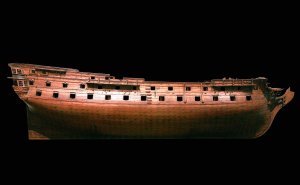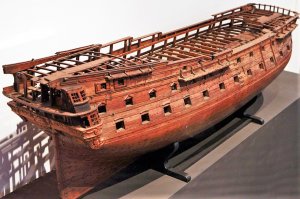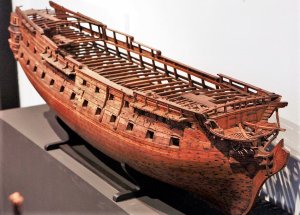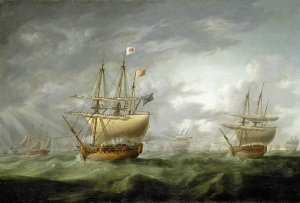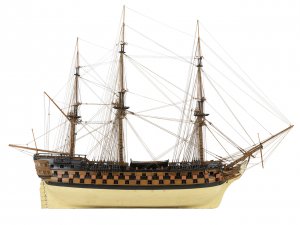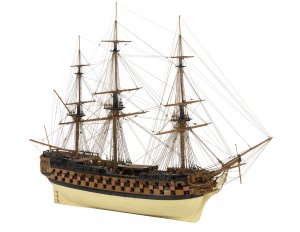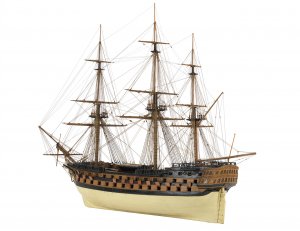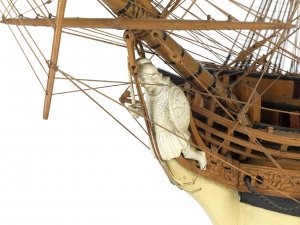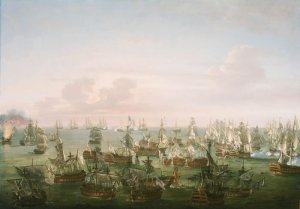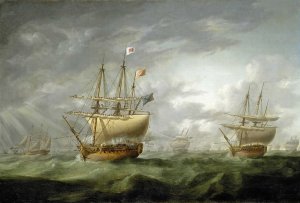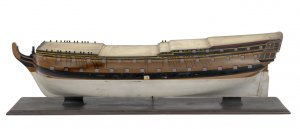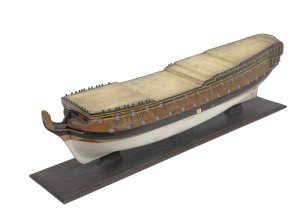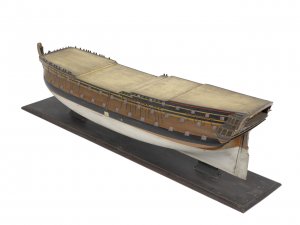Today in Naval History - Naval / Maritime Events in History
24 October 1944 - The Japanese battleship Musashi is sunk by American aircraft in the Battle of Leyte Gulf.
Musashi (武蔵), named after the former Japanese province, was one of two
Yamato-class battleships built for the Imperial Japanese Navy (IJN), beginning in the late 1930s. The
Yamato-class ships were the heaviest and most powerfully armed battleships ever constructed, displacing almost 72,000 long tons (73,000 t) fully loaded and armed with nine 46-centimetre (18.1 in) main guns. Their secondary armament consisted of four 15.5-centimetre (6.1 in) triple-
gun turrets formerly used by the
Mogami-class cruisers. They were equipped with six or seven floatplanes to conduct reconnaissance.
Commissioned in mid-1942,
Musashi was modified to serve as the
flagship of the
Combined Fleet, and spent the rest of the year
working up. The ship was transferred to
Truk in early 1943 and sortied several times that year with the fleet in unsuccessful searches for American forces. She was used to transfer forces and equipment between Japan and various occupied islands several times in 1944. Torpedoed in early 1944 by an American submarine,
Musashiwas forced to return to Japan for repairs, during which the navy greatly augmented her anti-aircraft armament. She was present during the Battle of the Philippine Sea in June, but did not come in contact with American surface forces.
Musashi was sunk by an estimated 19 torpedo and 17 bomb hits from American carrier-based aircraft on 24 October 1944 during the Battle of Leyte Gulf. Over half of her crew was rescued. Her wreck was located in March 2015 by Microsoft co-founder
Paul Allen and his team of researchers.
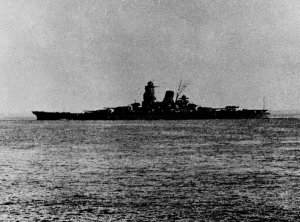
Japanese battleship
Musashi leaving Brunei in 1944 for the
Battle of Leyte Gulf
Design and description
Main article:
Yamato-class battleship
Since the navy anticipated they would be unable to produce as many ships as the United States, the
Yamato-class ships with their great size and heavy armament were designed to be individually superior to American battleships.
Musashi had a length of 244 metres (800 ft 6 in)
between perpendiculars and 263 metres (862 ft 10 in)
overall. She had a
beam of 36.9 metres (121 ft 1 in)
[5] and a
draught of 10.86 metres (35 ft 8 in) at deep load.
[6] she displaced 64,000 long tons (65,000 t) at
standard load and 71,659 long tons (72,809 t) at deep load. Her crew consisted of 2,500 officers and enlisted men in 1942, and about 2,800 in 1944.
The battleship had four sets of Kampon geared steam turbines, each of which drove one propeller shaft. The turbines were designed to produce a total of 150,000 shaft horsepower (110,000 kW), using steam provided by 12 Kampon water-tube boilers, to give her a maximum speed of 27 knots (50 km/h; 31 mph). She had a stowage capacity of 6,300 long tons (6,400 t) of
fuel oil, giving a range of 7,200 nautical miles (13,300 km; 8,300 mi) at a speed of 16 knots (30 km/h; 18 mph).
Construction
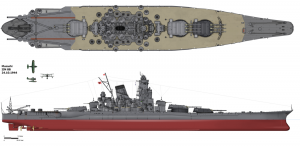 Musashi
Musashi as she appeared in mid-1944
To cope with
Musashi's great size and weight, the construction slipway was reinforced, nearby workshops were expanded, and two
floating cranes were built. The ship's
keel was laid down on 29 March 1938 at Mitsubishi's Nagasaki shipyard, and was designated "Battleship No. 2". Throughout construction, a large curtain made of hemp rope weighing 408 t (450 short tons) prevented outsiders from viewing construction.
Launching the
Musashi also presented problems. The ship's 4-metre (13 ft 1 in) thick launch platform, made of nine 44 cm (17 in)
Douglas fir planks bolted together, took two years to assemble (from keel-laying in March 1938) because of the difficulty in drilling perfectly straight bolt holes through 4m of fresh timber. The problem of slowing and stopping the massive hull once inside the narrow Nagasaki Harbour was met by attaching 570 tonnes (560 long tons) of heavy chains on both sides of the hull to create dragging resistance in the water. The launch was concealed by means including a citywide
air-raid drill staged on the launch day to keep people inside their homes.
Musashi was launched on 1 November 1940, coming to a stop only 1 metre (3.3 ft) in excess of the hull's expected 220 metres (720 ft) travel distance across the harbour. The entry of such a large mass into the water caused a 120 cm (3 ft 11 in)
tsunami, which swept the harbour and local rivers, flooding homes and capsizing small fishing boats.
Musashi was fitted out at nearby Sasebo, with
Captain Kaoru Arima assigned as her commanding officer.
Towards the end of fitting out, the ship's flagship facilities, including those on the
bridge and in the admiral's
cabins, were modified to satisfy Combined Fleet's desire to have the ship equipped as the primary flagship of the commander-in-chief, as her sister
Yamato was too far along for such changes. These alterations, along with improvements in the secondary battery armour, pushed back completion and pre-handover testing of
Musashi by two months, to August 1942.
Service
Musashi was commissioned at Nagasaki on 5 August 1942, and assigned to the 1st Battleship Division together with
Yamato,
Nagato, and
Mutsu. Beginning five days later, the ship conducted machinery and aircraft-handling trials near Hashirajima. Her secondary armament of twelve 127 mm guns, 12 triple 25 mm gun mounts, and four 13.2 mm (0.52 in) anti-aircraft machine guns was fitted from 3–28 September 1942 at Kure, as well as a Type 21 radar. The ship was
working up for the rest of the year. Captain Arima was promoted to rear admiral on 1 November.
Musashi was assigned to the
Combined Fleet, commanded by Admiral Isoroku Yamamoto, on 15 January 1943
[22] and sailed for Truk three days later, arriving on 22 January. On 11 February, she replaced her sister ship
Yamato as the fleet's flagship. On 3 April, Yamamoto left
Musashi and flew to
Rabaul, New Britain to personally direct "Operation
I-Go", a Japanese aerial offensive in the Solomon Islands. His orders were intercepted and deciphered by Magic, and American Lockheed P-38 Lightning fighters shot down his aircraft and killed him in
Operation Vengeance while he was en route from New Britain to Ballale, Bougainville. On 23 April, his cremated remains were flown back to Truk and placed in his cabin on board
Musashi.
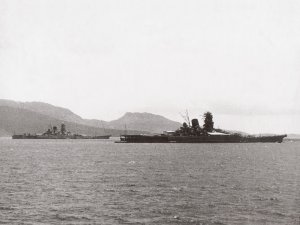 Musashi
Musashi and
Yamato in
Truk Lagoon in early 1943.
On 17 May, in response to American attacks on Attu Island,
Musashi—together with the carrier
Hiyō, two heavy cruisers, and nine destroyers—sortied to the northern Pacific. When no contact was made with American forces, the ships sailed to Kure on 23 May, where Yamamoto's ashes were taken from the vessel in preparation for a formal state funeral. Immediately afterwards,
Musashi's task force was significantly reinforced to counterattack American naval forces off Attu, but the island was captured before the force could intervene. On 9 June Arima was relieved by captain
Keizō Komura. On 24 June, while being overhauled at Yokosuka Naval Arsenal,
Musashi was visited by Emperor Hirohito and high-ranking naval officers. From 1 to 8 July, the ship was fitted with a pair of Type 22 radars at Kure. She sailed for Truk on 30 July and arrived there six days later, where she resumed her position as fleet flagship for Admiral Mineichi Koga.
In mid-October, in response to suspicions of planned American raids on Wake Island,
Musashi led a large fleet—three carriers, six battleships, and 11 cruisers—to intercept American forces, but failed to make contact and returned to Truk on 26 October. She spent the remainder of 1943 in Truk Lagoon. Captain Komura was promoted to rear admiral on 1 November and transferred to the 3rd Fleet on 7 December as Chief of Staff, Captain Bunji Asakura assuming command of
Musashi.
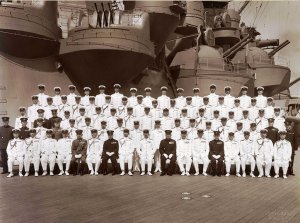 Emperor Hirohito
Emperor Hirohito and his staff on board
Musashi, 24 June 1943
The ship remained in Truk Lagoon until 10 February 1944, when she returned to Yokosuka. On 24 February,
Musashi sailed for
Palau, carrying one Imperial Japanese Army
battalion and another of Special Naval Landing Forces and their equipment. After losing most of her deck cargo during a typhoon, she arrived at Palau on 29 February and remained there for the next month. On 29 March,
Musashi departed Palau under cover of darkness to avoid an expected air raid, and encountered the submarine USS
Tunny, which fired six torpedoes at the battleship; five of them missed, but the sixth blew a hole 5.8 metres (19 ft) in diameter near the bow, flooding her with 3000 tonnes of water. The torpedo hit killed seven crewmen and wounded another eleven. After temporary repairs,
Musashi sailed for Japan later that night and arrived at Kure Naval Arsenal on 3 April. From 10 to 22 April, she was repaired and her anti-aircraft armament was substantially increased. When she undocked on 22 April, the ship's secondary battery comprised six 15.5 cm guns, twenty-four 12.7 cm guns, one hundred and thirty 25 mm guns, and four 13.2 mm machine guns. She also received new radars (which were still primitive compared to American equipment), and depth-charge rails were installed on her fantail.
In May 1944, captain Asakura was promoted to rear admiral and
Musashi departed Kure for
Okinawa on 10 May, then for Tawi-Tawi on 12 May. She was assigned to the 1st Mobile Fleet, under the command of
Vice Admiral Jisaburō Ozawa, with her sister. On 10 June, the battleships departed Tawi-Tawi for Batjan under the command of Vice Admiral Matome Ugaki, in preparation for
Operation Kon, a planned counterattack against the American invasion of Biak. Two days later, when word reached Ugaki of American attacks on
Saipan, his force was diverted to the Mariana Islands. After they rendezvoused with Ozawa's main force on 16 June, the battleships were assigned to Vice Admiral Takeo Kurita's 2nd Fleet. During the Battle of the Philippine Sea,
Musashi was not attacked. Following Japan's disastrous defeat in the battle (also known as the "Great Marianas Turkey Shoot"), the Second Fleet returned to Japan. On 8 July,
Musashiand her sister embarked 3,522 men and equipment of the Army's 106th Infantry Regiment of the
49th Infantry Division and sailed for Lingga Island, where they arrived on 17 July.
Battle of Leyte Gulf
Main article:
Battle of Leyte Gulf
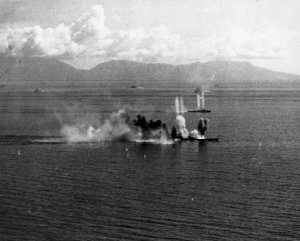 Musashi
Musashi under attack by American carrier aircraft during the
Battle of Leyte Gulf.
Captain Toshihira Inoguchi relieved Asakura in command of
Musashi on 12 August 1944 and was promoted to rear admiral on 15 October. Three days later, she sailed for
Brunei Bay, Borneo, to join the main Japanese fleet in preparation for "Operation
Sho-1", the counterattack planned against the American landings at Leyte. The Japanese plan called for Ozawa's carrier forces to lure the American carrier fleets north of Leyte so that Kurita's 1st Diversion Force (also known as the Central Force) could enter Leyte Gulf and destroy American forces landing on the island.
Musashi, together with the rest of Kurita's force, departed Brunei for the Philippines on 22 October.
The following day, the submarine USS
Dace torpedoed and sank the heavy cruiser
Maya near Palawan. The destroyer
Akishimo rescued 769 survivors and transferred them to
Musashi later in the day. On 24 October, while transiting the Sibuyan Sea, Kurita's ships were spotted by a reconnaissance aircraft from the
fleet carrier USS
Intrepid. Just over two hours later, the battleship was attacked by eight Curtiss SB2C Helldiver
dive bombers from
Intrepid at 10:27. One 500-pound (230 kg) bomb struck the roof of Turret No. 1, failing to penetrate. Two minutes later,
Musashi was struck starboard amidships by a torpedo from a
Grumman TBF Avenger, also from
Intrepid. The ship took on 3,000 long tons (3,000 t) of water and a 5.5 degree
list to starboard that was later reduced to 1 degree by counterflooding compartments on the opposite side. During this attack two Avengers were shot down.
An hour and a half later, another eight Helldivers from
Intrepid attacked
Musashi again. One bomb hit the upper deck and failed to detonate; another hit the port side of the deck and penetrated two decks before exploding above one of the engine rooms. Fragments broke a steam pipe in the engine room and forced its abandonment as well as that of the adjacent boiler room. Power was lost to the port inboard propeller shaft and the ship's speed dropped to 22 knots (41 km/h; 25 mph). Anti-aircraft fire shot down two Helldivers during this attack. Three minutes later, nine Avengers attacked from both sides of the ship, scoring three torpedo hits on the port side. One hit abreast Turret No. 1, the second flooded a hydraulic machinery room forcing the main turrets to switch over to auxiliary hydraulic pumps, and the third flooded another engine room. More counterflooding reduced the list to one degree to port, but the degree of flooding reduced the ship's forward freeboard by 6 feet (1.8 m). During this attack,
Musashi fired
sanshikidan anti-aircraft shells from her main armament; one shell detonated in the middle gun of Turret No. 1, possibly because of a bomb fragment in the barrel, and wrecked the turret's elevating machinery.
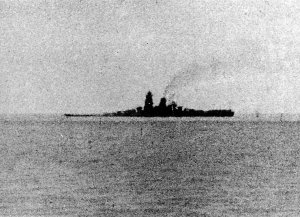 Musashi
Musashi down by the bow after the air attacks, shortly before her sinking.
At 13:31, the ship was attacked by 29 aircraft from the fleet carriers
Essex and
Lexington. Two Grumman F6F Hellcat fighters strafed the ship's deck and Helldivers scored four more bomb hits near her forward turrets.
Musashi was hit by four more torpedoes, three of which were forward of Turret No. 1, causing extensive flooding. The ship was now listing one degree to starboard, and had taken on so much water that her bow was now down 13 feet (4.0 m) and her speed had been reduced to 20 knots (37 km/h; 23 mph). Two hours later nine Helldivers from
Enterprise attacked with 1,000-pound (450 kg) armour-piercing bombs, scoring four hits. The ship was hit by three more torpedoes, opening up her starboard bow and reducing her speed to 13 knots (24 km/h; 15 mph). At 15:25,
Musashi was attacked by 37 aircraft from
Intrepid, the fleet carrier
Franklin and the
light carrier Cabot. The ship was hit by 13 bombs and 11 more torpedoes during this attack for the loss of three Avengers and three Helldivers. Her speed was reduced to 6 knots (11 km/h; 6.9 mph), her main
steering engine was temporarily knocked out and her
rudder was briefly jammed 15 degrees to port. Counterflooding reduced her list to six degrees to port from its previous maximum of ten degrees.
Musashi had been struck by an estimated total of 19 torpedoes and 17 bombs.
Kurita left
Musashi to fend for herself at 15:30, and encountered her again at 16:21 after reversing course. The ship was headed north, with a list of 10 degrees to port, down 26 feet (7.9 m) at the bow with her
forecastle awash. He detailed a heavy cruiser and two destroyers to escort her while frantic efforts were made to correct her list, including flooding another engine room and some boiler rooms. Her engines stopped before she could be
beached. At 19:15 her list reached 12 degrees and her crew was ordered to prepare to abandon ship, which they did fifteen minutes later when the list reached 30 degrees.
Musashi capsized at 19:36 and sank in 4,430 feet (1,350 m). Inoguchi chose to go down with his ship; 1,376 of her 2,399-man crew were rescued. About half of her survivors were evacuated to Japan, and the rest took part in the defence of the
Philippines. The destroyer
Shimakaze rescued 635 of
Maya's survivors from
Musashi.
https://en.wikipedia.org/wiki/Japanese_battleship_Musashi

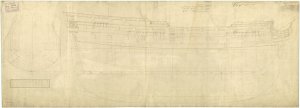
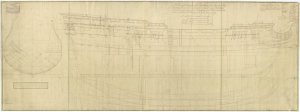
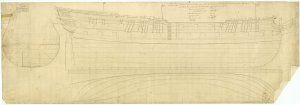

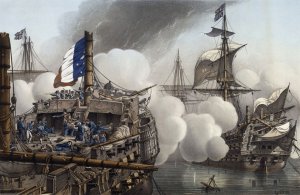
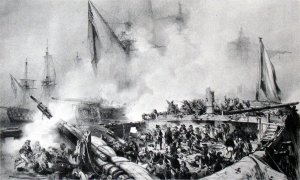
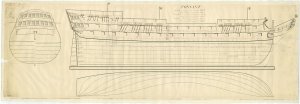
 Baum and Maasulys on 2 and 4 June. Tonnant then was one of the vessels that shared in the recapture on 27 August of the Lord Nelson.
Baum and Maasulys on 2 and 4 June. Tonnant then was one of the vessels that shared in the recapture on 27 August of the Lord Nelson.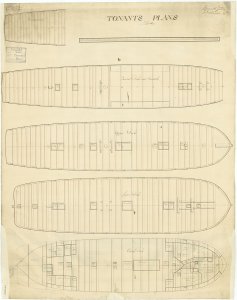
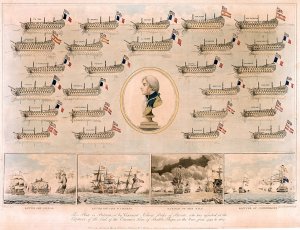
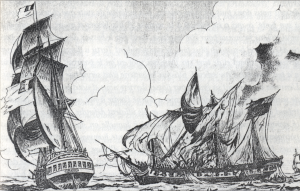
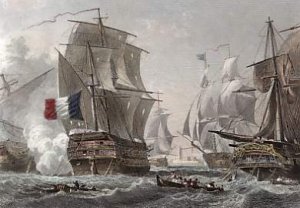
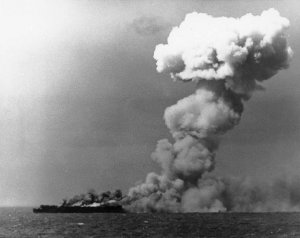










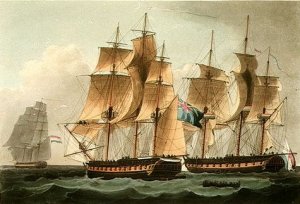
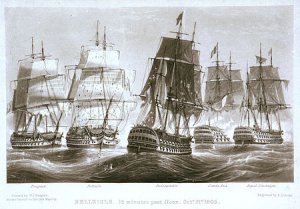
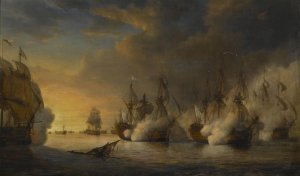
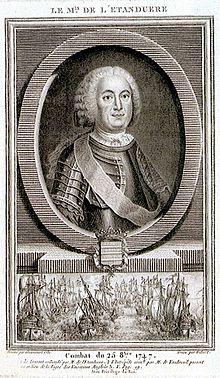
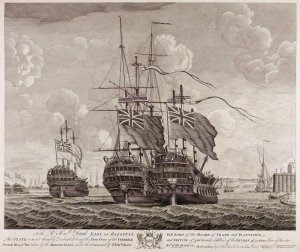
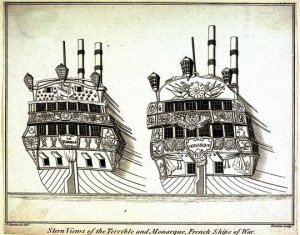
 Britain (Edward Hawke)
Britain (Edward Hawke) France (des Herbiers de l'Etenduère)
France (des Herbiers de l'Etenduère)